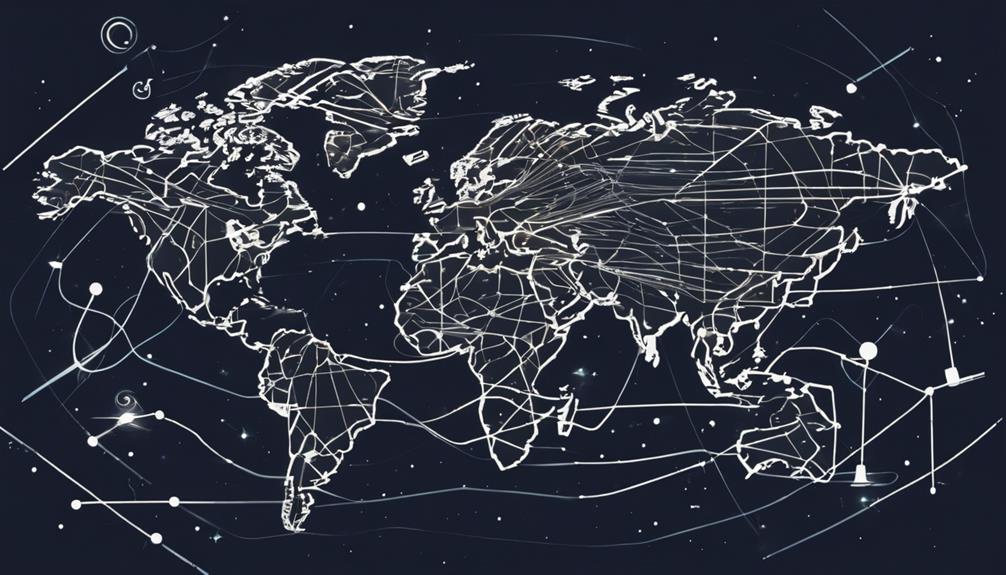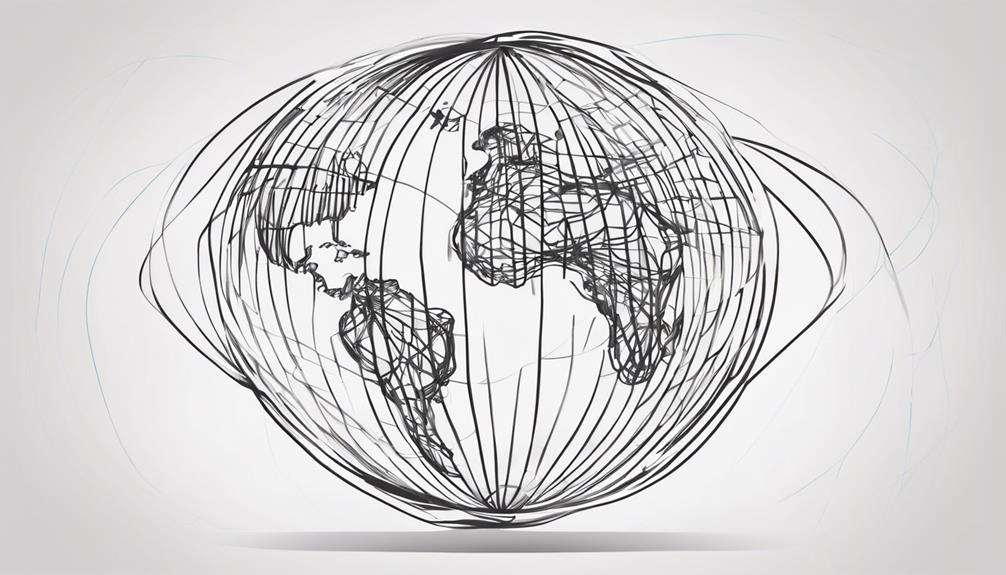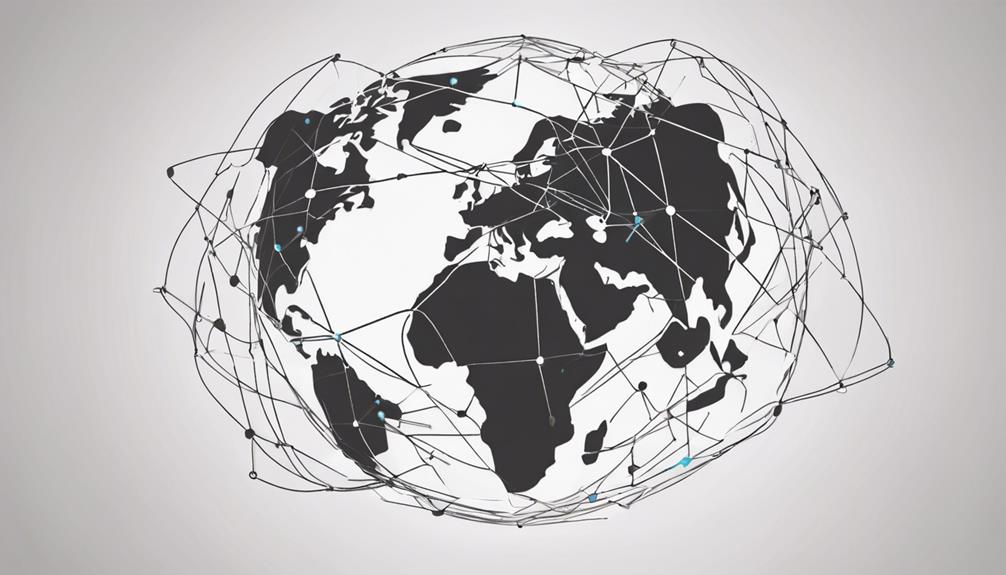The internet, a vast web of interconnected nodes, serves as a virtual highway that links individuals, businesses, and nations on a global scale. Through intricate infrastructure comprising undersea cables, data centers, and satellite communication, the internet acts as a conduit for the exchange of information and ideas across borders and time zones. As we navigate this digital landscape, the question arises: how does this intricate system of connections shape our understanding of the world and influence our interactions? The answer lies in unraveling the complexities of internet connectivity, exploring its impact on societies, economies, and the very fabric of our daily lives.
Key Takeaways
- Undersea cables and satellite networks ensure global connectivity.
- Internet infrastructure relies on standardized protocols for seamless operation.
- Over 95% of global communications are facilitated by undersea cables.
- Future trends indicate increased demand for enhanced internet connectivity.
The Internet Infrastructure Overview

Indispensable components such as routers, switches, web servers, and data centers form the foundational framework of the internet infrastructure, enabling the seamless transmission of data and delivery of digital content worldwide. Data centers play a pivotal role in storing and serving online content, ensuring efficient access for users. These centers are strategically located to optimize data processing and reduce latency, enhancing the overall user experience. Additionally, undersea cables are vital in connecting continents and facilitating global communication, with over 95% of data transmitted through these underwater networks. The strategic placement of data centers near undersea cable landing points further boosts connectivity and speeds up data transfer. By integrating these components, the internet infrastructure establishes a robust network that supports the continuous flow of information across the globe. This interconnected system operates through standardized protocols like TCP, TLS, and HTTP, which govern the secure transmission of data and the establishment of reliable connections.
Global Network of Undersea Cables
The intricate network of undersea cables represents a pinnacle of technological achievement, enabling the seamless flow of international data across vast distances. These cables are fundamental to the reliability and security of global communication systems, underpinning the interconnectedness of nations in today's digital age. Understanding the evolution and advancements in undersea cable technology is paramount to appreciating the efficiency and speed at which information traverses the world.
Undersea Cable Technology
Interwoven beneath the world's oceans lies a complex network of undersea cables, serving as the vital arteries of global communication infrastructure.
- The first successful transatlantic cable was laid in 1886 by the ship SS Great Eastern, a groundbreaking achievement in undersea communication.
- Over 95% of global communications rely on the 229 undersea cables spanning oceans, each as thin as a soda can.
- Undersea cables are favored over satellites for their stability, reliability, and high-speed data transmission capacity.
- The Oxford Internet Institute has meticulously mapped the intricate web of fiber-optic connections that underpin global internet connectivity, highlighting the essential role of undersea cables in our digital world.
International Data Transmission
A critical component of global data transmission infrastructure is the extensive network of undersea cables crisscrossing the world's oceans. These undersea cables, responsible for carrying 99% of international data, cover thousands of miles on the ocean floor. With 229 underwater cables globally, each as thin as a soda can, they play a crucial role in facilitating global connectivity. The first successful transatlantic cable laid in 1886 marked a significant milestone in underwater communication, paving the way for modern data transmission. Compared to satellites, undersea cables are preferred for their stability and reliability. The meticulous mapping of the world's intricate network of fiber-optic connections by the Oxford Internet Institute highlights the vital role of undersea cables in international data transmission.
Network Reliability and Security
Network Reliability and Security in the global undersea cable infrastructure is paramount for ensuring uninterrupted international data transmission.
- Over 98% of international Internet traffic relies on undersea cables, showcasing their indispensable role in global connectivity.
- Undersea cables, with optical fiber strands thinner than a human hair, facilitate high-speed data transmission between continents.
- With more than 420 undersea cables spanning around 1.3 million kilometers worldwide, these cables interconnect regions across the globe.
- Seismic activities and human interventions such as fishing and anchoring present notable threats to undersea cables, necessitating constant maintenance and surveillance.
The resilience and security of undersea cables are crucial for the seamless flow of vast amounts of data with minimal delays, supporting global information exchange.
Role of Data Centers in Connectivity
Data centers serve as the backbone of global connectivity by storing and processing vast amounts of digital information. Acting as critical hubs, these centers facilitate the exchange of data between different networks and service providers, ensuring fast and reliable access to online content and services. The strategic placement of data centers and interconnection points optimizes internet traffic flow, supporting the seamless functioning of network infrastructure on a global scale.
Data Center Functions
Nestled at the core of the digital ecosystem, data centers epitomize the fundamental infrastructure underpinning seamless global connectivity.
- Data centers store and serve online content, acting as hubs for information distribution.
- They provide secure and reliable storage for websites, applications, and digital services.
- Data centers house servers that process and transmit data to users across the globe.
- These facilities play a crucial role in ensuring fast and efficient connectivity for internet users.
Data centers are the backbone of the internet's functionality, where vast amounts of data are stored, processed, and disseminated. Through these centralized hubs, the Internet travels, connecting users worldwide and enabling the swift exchange of information essential for the modern digital age.
Global Connectivity Hub
At the heart of the digital infrastructure that powers global connectivity, data centers serve as pivotal nodes for storing and processing vast amounts of digital information. These data centers are instrumental in enabling global connectivity by housing the necessary servers and networking equipment that facilitate the transfer of data across the Internet. Through interconnection points within these centers, various networks and service providers can connect and exchange data efficiently. The seamless communication between users worldwide is made possible by the efficient data routing facilitated by data centers. In essence, data centers play a critical role in supporting the infrastructure required for the Internet to effectively connect the world, acting as the central hub for global connectivity.
Network Infrastructure Support
Within the intricate web of global connectivity, the fundamental backbone that supports the seamless transfer of data across the Internet lies in the robust network infrastructure provided by data centers.
- Data centers store and process vast amounts of digital information, ensuring efficient access and delivery.
- These centers are equipped with servers, networking devices, and storage systems essential for supporting internet connectivity.
- Interconnected through high-speed networks, data centers guarantee the smooth flow of data across the web.
- Cloud computing services heavily rely on data centers to host applications and provide various online services.
Data centers play a critical role in upholding the global network infrastructure, essential for facilitating internet connectivity and ensuring the seamless operation of digital services worldwide.
Internet Exchange Points Importance
Internet Exchange Points (IXPs) play a pivotal role in optimizing network performance and fostering global connectivity by facilitating direct interconnections between diverse networks. These crucial locations enable more efficient data exchange by allowing networks to connect directly, reducing the need for costly third-party transit providers. By promoting direct connections, IXPs enhance network efficiency, leading to faster data transmission, lower latency, and improved network resilience. Major IXPs like DE-CIX in Frankfurt and AMS-IX in Amsterdam serve as vital hubs for global Internet traffic exchange, facilitating the flow of data across regions. Moreover, the presence of IXPs supports the growth of local Internet ecosystems and contributes to the development of digital economies worldwide. In essence, IXPs are instrumental in enhancing network performance, reducing costs, and strengthening global connectivity by enabling direct interconnections between networks, ultimately playing a significant role in the efficient functioning of the internet infrastructure.
Impact of Satellite Communication

Satellite communication plays a pivotal role in extending connectivity to remote regions worldwide, bridging the digital divide and enabling real-time data transmission. With global coverage capabilities, satellites offer a reliable means of communication for areas where traditional infrastructure is impractical. The impact of satellite communication is not only evident in facilitating remote area connectivity but also in supporting essential services like weather monitoring and GPS navigation.
Global Reach via Satellites
How does satellite communication revolutionize global connectivity, particularly in areas where traditional undersea cables fall short?
- Satellite communication offers global internet coverage, bridging connectivity gaps in remote regions.
- Satellites orbit the Earth, facilitating data transmission to areas where undersea cables are impractical.
- Industries like maritime and aviation rely on satellite internet to maintain communication outside undersea cable networks.
- Satellite networks serve as backup links in case of undersea cable failures or interruptions.
Satellite technology plays a crucial role in expanding internet access worldwide, especially in areas underserved by traditional infrastructure like undersea cables. Companies such as SpaceX are actively deploying satellite constellations to enhance global connectivity through satellite communication.
Real-Time Data Transmission
The seamless transmission of real-time data facilitated by satellite communication technology revolutionizes global connectivity across various sectors, enhancing efficiency and reliability in critical operations. Satellite networks play a pivotal role in bridging remote areas with internet connectivity, overcoming the limitations of traditional terrestrial infrastructure. By relaying signals through satellites orbiting the Earth, services like telecommunication and broadcasting are made accessible even in challenging terrains. Real-time data transmission via satellites is essential for various applications such as disaster management, weather forecasting, and remote monitoring. Moreover, satellite communication is instrumental in connecting ships, airplanes, and remote research stations with the rest of the world, ensuring constant communication and data exchange. In essence, satellite technology is a cornerstone in the network of cables that form the backbone of global Internet connectivity.
Remote Area Connectivity
In the realm of global connectivity, the impact of satellite communication on remote area connectivity is undeniable and transformative.
- Satellite communication provides internet connectivity to remote areas where undersea cables are not feasible.
- Satellites in geostationary orbit relay signals between remote locations and ground stations for internet access.
- Satellite internet is crucial for connecting isolated communities, ships at sea, and aircraft in flight.
- The latency in satellite internet can be higher compared to undersea cables due to the longer signal travel distance.
Despite its limitations, satellite communication plays a vital role in extending internet connectivity to underserved regions globally. The ability to reach remote areas through satellites in geostationary orbit showcases the technological advancements that bridge the digital divide.
DNS and IP Addressing Basics

Decentralized and essential to the functioning of the internet, the Domain Name System (DNS) plays a critical role in translating human-readable domain names into numerical IP addresses for seamless connectivity. IP addresses are fundamental to the internet as they identify devices and enable data routing. DNS servers store domain name records, ensuring efficient mapping between domain names and IP addresses. Domain names provide a user-friendly way to access websites, simplifying the process for individuals. Concurrently, IP addresses serve as the backbone for data packet routing across the internet, ensuring information reaches its intended destination accurately and promptly. Understanding the basics of DNS and IP addressing is crucial for navigating the intricacies of the internet and comprehending how data is transmitted between devices. By bridging the gap between human-readable domain names and numerical IP addresses, DNS facilitates the smooth and efficient operation of the internet, enhancing global connectivity and communication.
Cloud Computing and Connectivity
Interwoven with the foundational infrastructure of DNS and IP addressing, cloud computing emerges as a transformative force in enabling global connectivity through the efficient utilization of shared resources and services over the Internet.
- Cloud computing enables global connectivity by providing on-demand access to shared resources and services over the Internet, allowing for seamless communication and collaboration across continents.
- Companies leverage cloud services to store data, run applications, and deliver content to users worldwide, enhancing accessibility and availability on a global scale.
- The scalability and cost-effectiveness of cloud computing reduce the reliance on physical infrastructure, offering businesses flexible and efficient solutions for expanding their operations internationally.
- Connectivity through cloud services fosters innovation, facilitates real-time collaboration, and streamlines communication channels, revolutionizing how organizations operate and connect with a diverse global audience.
The growth of cloud computing has significantly impacted the landscape of global connectivity, empowering businesses to transcend geographical boundaries and operate in a digitally interconnected world.
Social Media's Role in Global Connection

Social media platforms, such as Facebook, Twitter, and Instagram, play a pivotal role in fostering global connections and facilitating cross-cultural communication and information exchange among over 4.2 billion users worldwide. With Facebook leading as the most widely used social network, followed by Twitter and Instagram, these platforms have become essential tools in connecting individuals, businesses, and communities across the globe. Through real-time interactions and content sharing, social media transcends geographical boundaries, allowing users to engage with diverse cultures and languages instantaneously.
In the context of global connection, social media serves as a virtual bridge that connects people from different parts of the world, including the United States. By enabling users to share thoughts, ideas, and experiences, these platforms contribute to a more interconnected world where information flows freely and connections are formed beyond traditional barriers. As a result, the Internet, through social media, plays a crucial role in shaping the way individuals and societies connect and interact on a global scale.
Mobile Internet and Accessibility
The surge in mobile internet accessibility, now embraced by over 5.2 billion individuals globally, heralds a transformative era of connectivity and empowerment across all corners of the world.
- Developing countries are experiencing significant growth in mobile internet usage, bridging the digital divide and connecting more people to the online world.
- Mobile internet provides convenient access to information and services, empowering users in various aspects of their daily lives.
- The expansion of 4G and 5G networks has enhanced mobile internet speeds and coverage, improving connectivity for users worldwide.
- Mobile internet usage is transforming industries and economies, driving innovation, e-commerce, and digital inclusion on a global scale.
The accessibility of mobile internet in developing countries is not only reshaping how individuals interact with the digital realm but also revolutionizing economies. As more people gain access to the internet through their mobile devices, opportunities for education, entrepreneurship, and social connectivity expand. The continuous improvement of mobile networks further propels this progress, promising a future where connectivity knows no bounds.
Cybersecurity in Global Connectivity

Safeguarding international data transmission through undersea cables is imperative for ensuring global cybersecurity in the interconnected digital landscape. Undersea cables play a crucial role in carrying 99% of international data, highlighting their significance in maintaining secure and reliable global connectivity. Encryption and cybersecurity measures are employed to protect the information flowing through these cables, mitigating the risks of breaches and ensuring data security and privacy in global communication networks. However, concerns arise regarding potential legal access to this data by governments, raising issues related to privacy and security. The presence of redundant undersea cables further underscores the importance of cybersecurity in global internet transmission by ensuring continuous connectivity and data protection. As the reliance on undersea cables for international data transmission continues to grow, implementing robust cybersecurity practices remains essential to safeguarding sensitive information and maintaining the integrity of global connectivity channels.
Future of Internet Expansion
With the surge in demand for global connectivity, the future of internet expansion is poised to revolutionize the digital landscape through advancements in underwater communication technology.
- Growing Demand: There are 21 planned routes for additional underwater cables, highlighting the increasing need for global connectivity.
- Critical Backbone: The internet heavily relies on a complex network of underwater cables to meet the expanding requirements for data transmission.
- Essential Stability: The stability and reliability of undersea cables are crucial for ensuring uninterrupted global connectivity.
- Technological Advancements: Progress in underwater communication technology is reshaping the future of internet infrastructure, paving the way for enhanced connectivity worldwide.
As technology evolves, the internet's infrastructure will continue to advance, meeting the demands of emerging technologies and the interconnected nature of our global society. These advancements in underwater cables and communication technology will play a pivotal role in shaping the future of internet expansion, ensuring a more connected and accessible digital world for all.
Frequently Asked Questions
How Does the Internet Connect People?
Communication on the Internet connects people globally through various platforms such as social media. Online communities and networking sites facilitate interaction and relationships beyond geographical boundaries. The Internet serves as a conduit for sharing ideas, information, and experiences, fostering connections that transcend physical limitations. Through virtual channels, individuals can engage in dialogue, collaborate on projects, and establish meaningful connections, contributing to a more interconnected world.
How Is Internet Connected to Everyone?
Global access to the internet is achieved through a complex network of undersea cables, satellites, and terrestrial connections. Online communication is made possible by the seamless integration of these technologies, ensuring connectivity for billions of users worldwide. The internet serves as a conduit for information exchange, enabling individuals to interact, collaborate, and access a wealth of knowledge. This interconnected web of digital infrastructure underpins the modern world's communication landscape.
How Does a Country Connect to the Internet?
A country connects to the Internet through a complex infrastructure involving Internet Service Providers (ISPs) that establish links to undersea cables, fiber-optic connections, and satellite links for international data exchange. This network infrastructure allows for the interconnection of networks at Internet Exchange Points (IXPs), facilitating efficient data routing. Governments regulate and oversee these connections to ensure security and reliability, enabling countries to access the global Internet ecosystem through their network providers.
How Is the Internet Connected Through Different Continents in the World?
Underwater cables, also known as submarine communication cables, form the backbone of international internet connectivity. These cables are laid on the ocean floor, connecting continents and facilitating the transmission of data across vast distances. Satellite connections, though available, are more commonly used in remote or challenging terrains where laying cables is impractical. The interplay between these two technologies ensures that the internet is connected seamlessly across different continents, enabling global communication and information exchange.
Conclusion
In conclusion, the internet serves as a vital tool in connecting individuals, businesses, and communities globally through its vast network infrastructure. With the exponential growth of users and the reliance on undersea cables, data centers, internet exchange points, and satellite communication, the internet continues to shape the way we interact and collaborate on a global scale. As we look towards the future, the internet's expansion will undoubtedly reach unprecedented levels, solidifying its position as the backbone of global connectivity.
